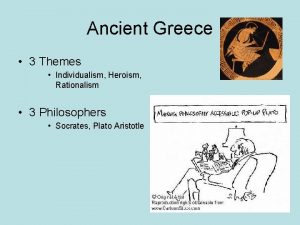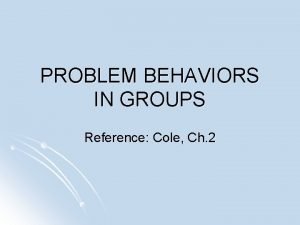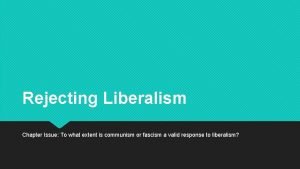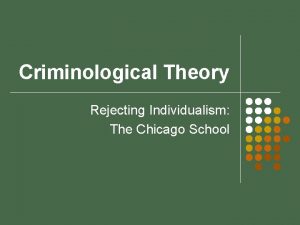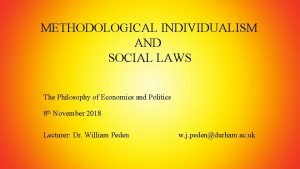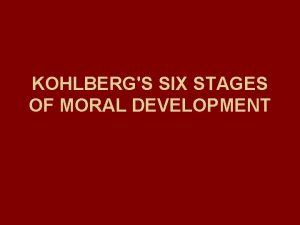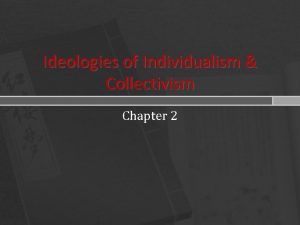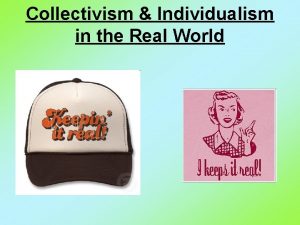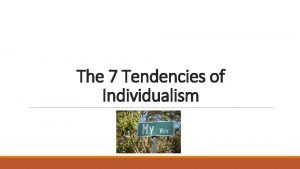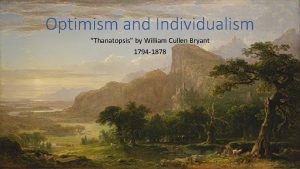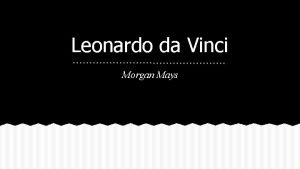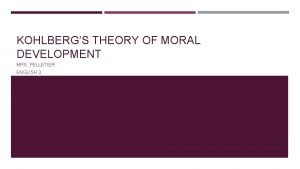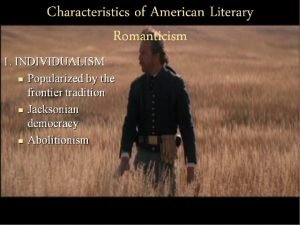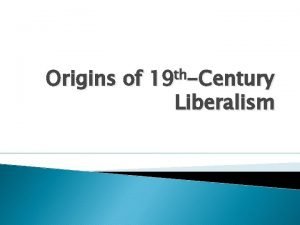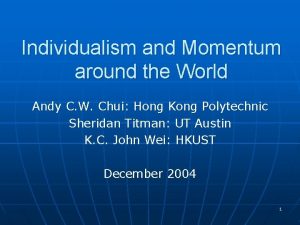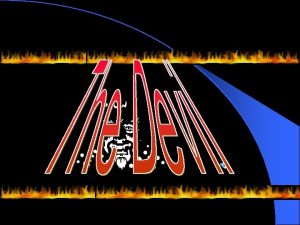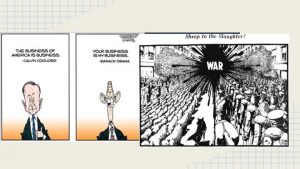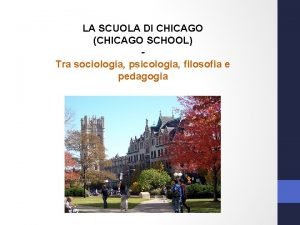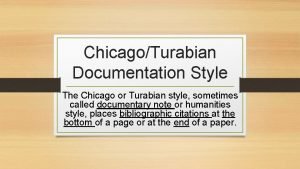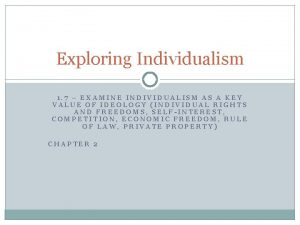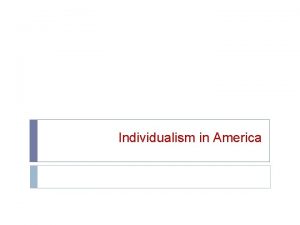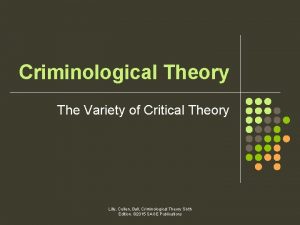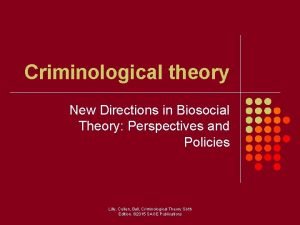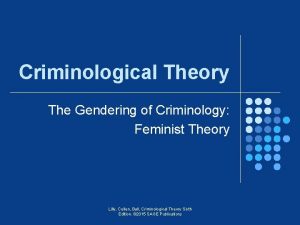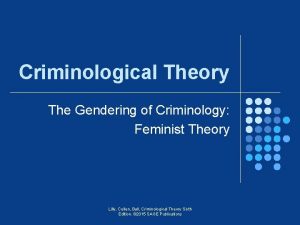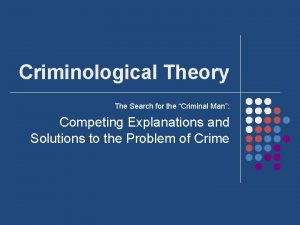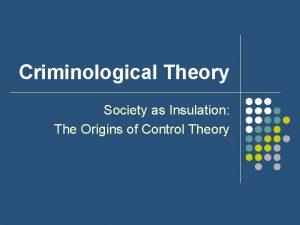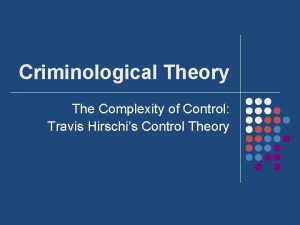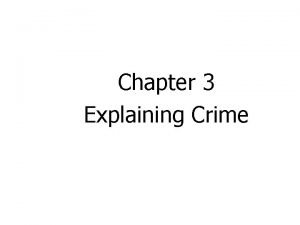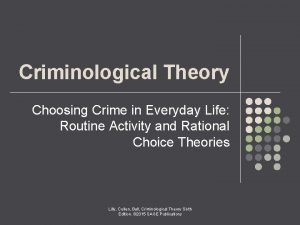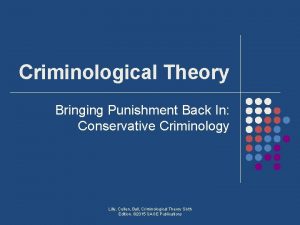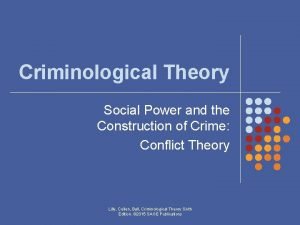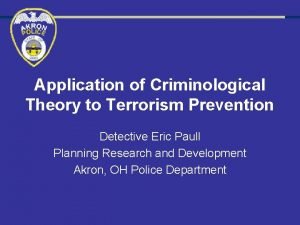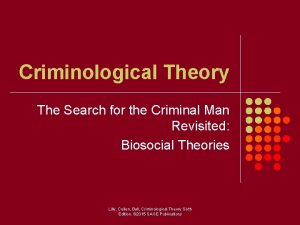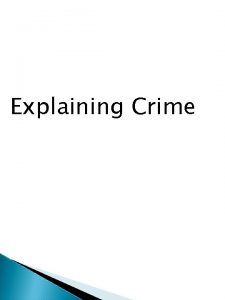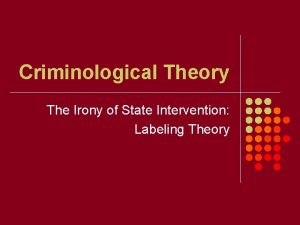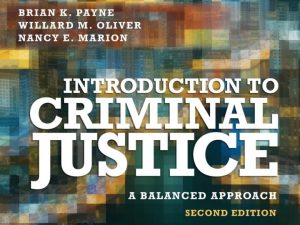Criminological Theory Rejecting Individualism The Chicago School Chicago





















































- Slides: 53

Criminological Theory Rejecting Individualism: The Chicago School

Chicago School Criminologists l l l l l Robert Park: Crime and the city Park and Burgess: Concentric Zone Theory Shaw and Mc. Kay: Social Disorganization theory and the Chicago Area Project Sutherland: Differential Association Sampson and colleagues: Collective Efficacy Bursik and Grasmick: Collective Efficacy Warner: Cultural attenuation theory Legal Cynicism Theory Elijah Anderson’s Cultural Deviance Theory: Code of the Street Aker: Social Learning Theory

Introduction l As the United States entered the 20 th century, a competing vision of crime emerged l Crime was a social product l The Chicago school of criminology argued that one aspect of American society, the city, contained potent criminogenic forces

The Chicago School of Criminology: Theory in Context l During the latter half of the 1800 s, cities grew at a rapid pace, and became “a controlling factor in national life” l Chicago’s growth was particularly remarkable l Grew from 4, 100 residents in 1833 to over 2 million in 1910 l Many of those settling in Chicago carried little with them l Most newcomers brought little economic relief l Referred to as “the jungle” by Upton Sinclair

The Chicago School of Criminology: Theory in Context l Criminologists during the 1920 s and 1930 s witnessed that these changes created bulging populations and teaming slum areas l They believed that growing up in the city, particularly in the slums, made a difference in people’s lives

The Progressive Movement l The “Progressives” were troubled by the plight of the urban poor, a mushrooming population of the system’s casualties who had few prospects of stable or rewarding lives l An understanding of the etiology of crime demanded a very close scrutiny of the conditions of the urban poor

The Progressive Movement l The Progressives believed that the poor were pushed by their environment into lives of crime l The goal was to save the poor by providing social services that would lessen the pains of poverty and teach the benefits of middle-class culture l Did this through schools, clinics, recreational facilities, settlement houses, foster homes, and reformatories

The Age of Reform l The Progressives efforts led to the creation of policies and practices that were intended to allow the state to treat the individual needs and problems of offenders l l Trusted the government The city became a dominant feature of American life, and a pervasive movement arose warning that the social fabric of urban slums bred crime

The University of Chicago and Robert Park l Concluded that the city’s development and organization were not random l l Rather development is patterned and could be understood in terms of the basic social processes The nature of social processes and their impact on human behavior could be ascertained only through a careful study of city life

Shaw and Mc. Kay’s Theory of Juvenile Delinquency l Persuaded that a model of the city formulated by Ernest Burgess provided a framework for understanding the social roots of crime l Neighborhood organization was instrumental in the preventing or permitting delinquent careers

Burgess’s Concentric Zone Theory

Burgess’s Concentric Zone Theory l Cities grow radially in a series of five concentric zones l Competition determined how people were distributed spatially among these zones l The zone of transition was a cause for concern and study l Deteriorating houses, displacement of residents, and waves of immigrants lead to weakened family and communal ties and resulted in social disorganization

Shaw and Mc. Kay’s Disorganization and Delinquency l Mapped the spatial distribution of delinquency throughout Chicago to see if it conformed to Burgess’s concentric zone theory l Delinquency flourished in the zone in transition and was inversely related to the zone’s affluence and corresponding distance from the central business district l True regardless of the racial or ethnic group residing there

Shaw and Mc. Kay’s Disorganization and Delinquency l The nature of the neighborhood, not individuals within the neighborhood, regulated involvement in crime l Neighborhood organization was the main factor determining juvenile waywardness l In the zone in transition, urban growth, transiency, heterogeneity, and poverty allowed social disorganization to prevail and delinquency to be rampant

Shaw and Mc. Kay’s Disorganization and Delinquency Growing up in a disorganized area, it is this combination of: l 1. 2. A break down of control Exposure to a criminal culture that lures individual youngsters into crime that creates high rates of delinquency

Transmission of Criminal Values l Shaw and Mc. Kay attempted to learn more about why youths become deviant by interviewing delinquents and compiling their autobiographies in a format called life histories l Found juveniles were drawn into crime through their association with older siblings or gang members l Disorganization produced and sustained criminal traditions

The Empirical Status of Social Disorganization Theory l Pratt and Cullen’s (2005) meta-analysis found the variables are related to crime in the predicted direction l Sampson and Groves (1989) found structural factors increased social disorganization and that, in turn, disorganized areas had higher levels of crime than organized areas

Summary of Social Disorganization Theory l Shaw and Mc. Kay believed that juvenile delinquency could only be understood by considering by the social context which youths lived l A disorganized areas there is (1) a breakdown of control and (2) exposure to a criminal culture l This theory is a considered a “mixed model” or “integrated theory” since it merges different causal conditions into a single explanation (weak controls and learning cultural values) l Laid the groundwork for control or social bond theories

Sutherland’s Differential Social Organization l Shaw and Mc. Kay’s work laid the groundwork for Edwin Sutherland’s differential association theory l Argued that social organization – the context in which individuals are embedded – regulates criminal behavior l Contended that groups are arranged differently; some are organized in support of criminal activity, whereas others are organized against such behavior

Sutherland’s Differential Association and Definitions l Criminal behavior is learned through social interactions l The inner-city is characterized by culture conflict between a conventional culture and an criminal culture that promote their own definitions l The ratio of definitions – criminal or conventional – determines if the person embraces crime an acceptable way of life

Sutherland’s Nine Propositions 1. Criminal behavior is learned 2. Criminal behavior is learned in interaction with other persons in a process of communication 3. The principle part of the learning of criminal behavior occurs within intimate personal groups

Sutherland’s Nine Propositions (cont’d) 4. When criminal behavior is learned, the learning includes (a) techniques of committing the crime, and (b) the specific direction of motives, drives, rationalizations, and attitudes 5. The specific direction of motives and drives is learned from definitions of legal codes as favorable and unfavorable

Sutherland’s Nine Propositions (cont’d) 6. A person becomes delinquent because of an excess of definitions favorable to the violation of law 7. Differential associations may vary in frequency, duration, priority, and intensity

Sutherland’s Nine Propositions (cont’d) 8. The process of learning criminal behavior by association with criminal and anti-criminal patterns involves all the mechanisms that are involved in other learning 9. While criminal behavior is an expression of general needs and values, it is not explained by those general needs and values since noncriminal behavior is not an expression of the same needs and values

Theoretical Applications l Sutherland believed differential association theory was a general explanation that could be applied to very divergent types of illegal activity l Claimed differential association could account for the offenses committed by persons of respectability and high social status in the course of his occupation– whitecollar crime

Sutherland White-Collar Crime l Crime committed by a person of respectability and high social status in the course of his occupation l Lawlessness is widespread in business, politics, and the professions l Differential association can explain this type of crime

The Chicago School’s Criminological Legacy l Emphasized the causal importance of the transmission of a criminal culture but offered much less detail on the precise origins of this culture l l No focus on the role of power and class domination The Chicago school laid the groundwork for the development of a perspective that remains vital to this day l Cultural deviance theory

Control and Culture in the Community l Theories have continued to explore why some communities have higher rates of crime than others l The control perspective derived from Shaw and Mc. Kay is seen in theories of collective efficacy and cultural attenuation l Other scholars have linked crime to cultural traditions in communities – Code of the Street l And still others have examined why some individuals are more likely to be involved in crime than others – Akers’s social learning theory

Collective Efficacy l Sampson sought to explain how informal social control at the community level explains variation in crime rates across neighborhoods l Known as the systemic theory l Neighborhoods are characterized by a system of social networks and ties § When dense and strong, there is informal social control § When weak, there is a lack informal social control

Collective Efficacy l Bursik and Grasmick presented three levels of community control 1. Private: intimate relationships among family and friends 2. Parochial: those met during daily routines and voluntary organizations 3. Public: relationships with external groups that provide resources to maintaining order l Organized communities have all three controls, while disorganized communities do not

Collective Efficacy l One problem with the systemic model l High crime communities have neighbors that often know one another and have strong private ties, while low crime areas have weak ties

Collective Efficacy l Sampson, Raudenbush, and Earls set forth a reconceptualization of the social disorganization framework called collective efficacy l l Neighborhoods vary in their ability to activate informal social control l l Defined as social cohesion among neighbors combined with their willingness to intervene on behalf of the common good Dependent on mutual trust and solidarity among neighbors In neighborhoods where cohesiveness prevails, residents can depend on one another to enforce rules of civility and good behavior which allows the area to have collective efficacy l Residents have a shared expectation for control

Collective Efficacy l Collective efficacy is not evenly distributed across neighborhoods l Studies have shown collective efficacy is a robust predictor of levels of violence across neighborhoods and mediated much of the relationship between crime and the neighborhood characteristics of residential stability and concentrated disadvantage l Is a promising explanation of why urban neighborhoods differ in their levels of criminal behavior

Cultural Attenuation Theory l Cultural Disorganization and Crime l Neighborhood conditions affect allegiance to conventional values l Difficult to have “common ground” and “shared understandings” when there is transiency, heterogeneity, when new problems exist that traditional values do not address effectively, and when following conventional mandates seem irrelevant to the achievement of goals l Community cannot organize itself to combat delinquency united by common values

Cultural Attenuation Theory l Warner found that concentrated disadvantage and residential mobility decrease allegiance to conventional values l Conventional values are not rejected but fall into “disuse” l Culture is strong with similar values are widely shared, visibly present in everyday life, and regularly articulated

Legal Cynicism Theory l Police are seen as absent or too present in high-crime, inner-city neighborhoods l Officers seen as unresponsive and disrespectful l Belief in law attenuates and legal cynicism occurs l l Legal cynicism is cultural orientation in which the law and its agents are viewed as illegitimate, unresponsive, and ill equipped to ensure public safety Concentrated disadvantage contributes to legal cynicism

Legal Cynicism Theory l Evidence to show neighborhoods high in legal cynicism have high rates of crime l However, does not mean residents condone crime l Legal cynicism creates conditions conducive to crime

Cultural Deviance Theory: Theoretical Variations l Communities are exposed to values oppositional to conventional culture l Cultural deviance theory has evolved among a number of paths l Some criminologists have asserted that lower-class culture as a whole is responsible for generating much criminality in urban areas l A number of criminologists have explored how delinquent subcultures arise in particular sectors of society l Other researchers have developed a similar theme in arguing for the existence of subcultures of violence

Cultural Deviance Theory: Code of the Street l Written by Elijah Anderson in 1999 l Sought to determine why so many inner-city young people are inclined to commit aggression and violence toward one another l Found a “street code” that values violence prevails in the inner city and that governs the choice that adolescents make in their daily lives

Cultural Deviance Theory: Code of the Street l Minority youth in the inner city are culturally isolated from conventional society and face economic barriers l l These youths’ major product is to campaign for respect l l Families can be disrupted and dysfunctional (“street families”) where the children are neglected and receive harsh physical and erratic discipline Display status through dress, masculine demeanor, and developing reputations for nerve A code of the street demands disrespect be met with immediate threat or application of violence

Cultural Deviance Theory: Code of the Street l The code affects not only kids from street families but also those from decent families l Youths from all families are encapsulated by the code of the street and suffer its consequences l The code of the street is not intractable l The code is a cultural adaptation to the conditions prevailing in destitute urban communities l Rooted in the structural conditions that expose youths to hurtful deprivations and strip them of any meaningful way of gaining respect through conventional avenues

Cultural Deviance Theory: Code of the Street l Anderson’s work subjected to few empirical tests l Mixed results l Some studies are supportive of the contention that structural sources contribute to involvement in violent delinquency l Others find no support that adopting the code increases safety § In fact, found embracement increased risk of victimization

Akers’s Social Learning Theory l Crime is learned behavior through social interaction with others l Incorporates four central concepts: 1. Differential association (interactive and normative) 2. Imitation 3. Definitions 4. Differential social reinforcement

Akers’s Social Learning Theory Key Concepts Definitions of Concepts 1. Differential Association The process through which individuals are exposed to definitions favorable and unfavorable to illegal or law-abiding behavior. The direct association and interactions with others who engage in certain kinds of behavior, as well as the indirect association and identification with more distant reference groups. The different patterns of norms and values to which an individual is exposed through this association. A person’s own attitudes or meanings that are attached to a given behavior. That is, definitions are orientations, rationalizations, definitions of the situation, and other evaluative and moral attitudes that define the commission of an act as right or wrong, good or bad, desirable or undesirable, justified or unjustified. The more a person’s definitions approve of an act, the greater the chances are that the act will be committed. General definitions are broad attitudes that approve of conventional behavior and disapprove of criminal behavior (e. g. , moral beliefs from religion). Specific definitions define certain acts as wrong (e. g. , killing a person) and other acts as permissible (e. g. , stealing a person’s computer). Negative definitions disapprove of a behavior. Positive definitions define the behavior as desirable or wholly permissible. Neutralizing definitions define an act as wrong but justify and thus permit the behavior “given the situation. ” Modeling—person engages in behavior after observing similar behavior in others. The balance of anticipated or actual rewards and punishments that follow or are the consequence of behavior. Most reinforcements leading to crime are social. A. Interactional dimension: B. Normative dimension: 2. Definitions A. General vs. specific B. Negative, positive, and neutralizing 3. Imitation 4. Differential Reinforcement

Akers’s Social Learning Theory: Definitions l Key factor in motivating crime l One’s attitudes or meanings attached to a behavior l Specified dimensions of definitions: l General Specific Negative toward criminal behavior l Positive toward criminal behavior l Neutralizing l l

Akers’s Social Learning Theory: Imitation l In addition to definitions, people can become involved in crime through imitation (modeling criminal conduct) l Definitions and imitation are most instrumental in determining initial forays into crime l Social reinforcements determine whether any behavior is repeated: Differential social reinforcement

Akers’s Social Learning Theory: Differential Reinforcement l Stronger and more persistent the rewards, the more likely criminal behavior will persist l l Nonsocial and social Social context in which individuals are enmeshed expose people to definitions, people to imitate, and with differential reinforcement

The Empirical Status of Social Learning Theory l Research is supportive of this perspective l The strongest predictor of criminal involvement is differential association as measured by the number of delinquent friends l Criticism: Rather than delinquent friends causing wayward behavior, this process is really a cause of “birds of a feather flock together” l Self-selection occurs but continued association with delinquent peers amplifies criminal involvement

Policy Implications: Change the Individual l Shaw and Mc. Kay: Reorganize communities l The Chicago School: Reverse criminal learning l Differential association and social learning theory often attempt to remove offenders from settings and people that encourage crime and to locate them in settings where they will receive pro-social reinforcement

Policy Implications: Change the Community l Solution to youthful waywardness is to eradicate the pathologies that lie within the fabric of disorganized communities l Shaw established the Chicago Area Project (CAP) to serve as a catalyst for the creation of neighborhood communities in Chicago’s disorganized slum areas

CAP’s Approach to Delinquency Prevention l A strong emphasis was placed on the creation of recreational programs l Efforts were made to have residents take pride in their community l CAP staff would attempt to mediate on behalf of juveniles in trouble l CAP used staff indigenous to the area so as to provide curbside counseling

CAP Effectiveness l Lack of evaluations using randomized designs l However, a 50 year assessment found that CAP had been effective in reducing rate of delinquency l Today, coordinates more than 40 projects and affiliates

Conclusion l The Chicago school elevated to prominence sociological over individual trait explanations of crime l Individuals are born into neighborhoods that differ in their organization which influences the likelihood that residents will be involved in crime l The Chicago school made methodological advances l Showed the value of mapping crime l Valued qualitative methods
 Define criminal psychology
Define criminal psychology Individualism in the school of athens
Individualism in the school of athens Asking for help expression
Asking for help expression Help rejecting complainer therapy
Help rejecting complainer therapy Samuel they have rejected me
Samuel they have rejected me Economic spectrum
Economic spectrum Social disorganization theory
Social disorganization theory Individualism in transcendentalism
Individualism in transcendentalism Methodological individualism weber
Methodological individualism weber Kohlberg stage 6
Kohlberg stage 6 Economic equality
Economic equality Examples of individualism
Examples of individualism Examples of individualism
Examples of individualism Seven tendencies of individualism
Seven tendencies of individualism Individualism in thanatopsis
Individualism in thanatopsis The dark side of individualism
The dark side of individualism Mona lisa individualism
Mona lisa individualism Stage 2 individualism and exchange
Stage 2 individualism and exchange Characteristic of american romanticism
Characteristic of american romanticism Individualism
Individualism Individualism and momentum around the world
Individualism and momentum around the world Individualism in the devil and tom walker
Individualism in the devil and tom walker Monologue themes
Monologue themes Cooperative individualism
Cooperative individualism Primo dipartimento di sociologia
Primo dipartimento di sociologia Menlo school library chicago style guide
Menlo school library chicago style guide Hình ảnh bộ gõ cơ thể búng tay
Hình ảnh bộ gõ cơ thể búng tay Slidetodoc
Slidetodoc Bổ thể
Bổ thể Tỉ lệ cơ thể trẻ em
Tỉ lệ cơ thể trẻ em Gấu đi như thế nào
Gấu đi như thế nào Tư thế worms-breton
Tư thế worms-breton Hát lên người ơi
Hát lên người ơi Môn thể thao bắt đầu bằng từ chạy
Môn thể thao bắt đầu bằng từ chạy Thế nào là hệ số cao nhất
Thế nào là hệ số cao nhất Các châu lục và đại dương trên thế giới
Các châu lục và đại dương trên thế giới Cong thức tính động năng
Cong thức tính động năng Trời xanh đây là của chúng ta thể thơ
Trời xanh đây là của chúng ta thể thơ Cách giải mật thư tọa độ
Cách giải mật thư tọa độ Làm thế nào để 102-1=99
Làm thế nào để 102-1=99 Phản ứng thế ankan
Phản ứng thế ankan Các châu lục và đại dương trên thế giới
Các châu lục và đại dương trên thế giới Thơ thất ngôn tứ tuyệt đường luật
Thơ thất ngôn tứ tuyệt đường luật Quá trình desamine hóa có thể tạo ra
Quá trình desamine hóa có thể tạo ra Một số thể thơ truyền thống
Một số thể thơ truyền thống Cái miệng xinh xinh thế chỉ nói điều hay thôi
Cái miệng xinh xinh thế chỉ nói điều hay thôi Vẽ hình chiếu vuông góc của vật thể sau
Vẽ hình chiếu vuông góc của vật thể sau Thế nào là sự mỏi cơ
Thế nào là sự mỏi cơ đặc điểm cơ thể của người tối cổ
đặc điểm cơ thể của người tối cổ Thế nào là giọng cùng tên?
Thế nào là giọng cùng tên? Vẽ hình chiếu đứng bằng cạnh của vật thể
Vẽ hình chiếu đứng bằng cạnh của vật thể Vẽ hình chiếu vuông góc của vật thể sau
Vẽ hình chiếu vuông góc của vật thể sau Thẻ vin
Thẻ vin đại từ thay thế
đại từ thay thế

